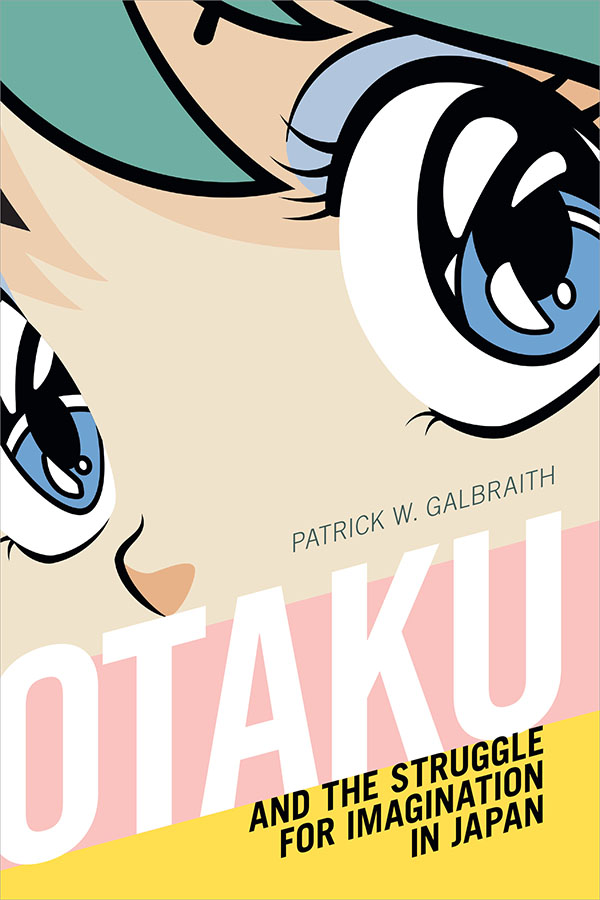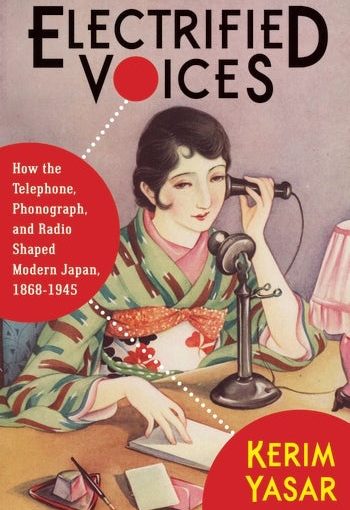Galbraith, Patrick W. Otaku and the Struggle for Imagination in Japan. Durham, NC: Duke University Press, 2019.
Caitlin Casiello
Since the emergence of anime as the vanguard for Japan’s battle for cultural relevancy through “Cool Japan” soft power, the “otaku” has loomed large as a figure of mystery, infamy, and transformation. In Otaku and the Struggle for Imagination in Japan, Patrick Galbraith draws on fieldwork and historical research to detangle the formation of “otaku” as fans and as cultural boogeymen. The “otaku” that emerges from this analysis is a construction of conflicting desires and discourses which nevertheless presents a possibility for a path towards imagining new worlds in our hyper-mediated society. The book is an important intervention against approaches to otaku culture which treat otaku as potentially-criminal deviants. It also stands against efforts to sanitize otaku life of its sexual elements; the book throughout emphasizes the centrality of sexuality-desire-eroticism-attachment to otaku identity. The book balances on a tight rope to show otaku as outsiders to dominant hegemonies despite frequently being coopted by nationalist and patriarchal efforts.
Chapter 1 analyzes the history of otaku sexuality by looking at male fans of shôjo manga. Rather than dismissing these fans—who would eventually originate the genre of lolicon—as perverts with a sexual desire for little girls, the book frames their interest in shôjo as an attraction to cuteness and girlness (21) and a shift from heterosexual male identification to minoritarian identification with girlhood. This complication intensifies in lolicon, where the erotic appeal is the potential for men to become the shôjo even while desiring her sexually (47); the erotics of lolicon are therefore not situated in a desire to destroy young girls, but in a desire to destroy the adult male self.
This pre-history of the otaku subculture leads into Chapter 2 on the emergence of otaku as a social problem to solve. The otaku created by 1980s media discourse is a problem for society and has a problem with reality, particularly after the 1989 murder of four young girls by supposed-otaku Miyazaki Tsutomu. Here, Galbraith uses the origins of the term otaku and its subsequent rise to public consciousness to examine the “reality problems” (51) of otaku: orientation away from reality towards fiction resulting in a lack of care for social norms and the otaku’s supposed confusion of reality and fiction meaning otaku could be predators for real children. The discussion focuses on the inherent contradiction between these two threats, i.e. how can they be predators for real children if they are also oriented away from reality?
In chapter 3, the book turns to the history of moe and otaku attachment. Moe has been one of the hardest terms to define for researchers in Japanese and English, but Galbraith does credit to its flexibility by tracing multiple origins of moe eroticism in works by Tezuka Osamu, Miyazaki Hayao, and Takahashi Rumiko. Moe, as a desire for fictional characters, here has the potential to overturn social realities by reorienting people away from forms of love and recognition which rely on capitalistic and hierarchal structures.
Chapter 4 takes us to otaku hotspot Akihabara, the Moe City, as it transforms from underground nerd paradise to a “cultural” property representing Japan to tourists under Cool Japan’s hostile recuperation of the “otaku.” The tale of crossplayers and other street performers forced to stop the performances that made Akihabara into a famed spot for self-expression captures the irony and sadness of the government’s attempts to support Japanese culture abroad.
Chapter 5 approaches another famous otaku space: the maid cafe. Through fieldwork with maid cafe visitors, Galbraith challenges the view of maid cafe visitors (and otaku more broadly) as “antisocial” by looking at their relationships with the maids as different form of sociality created by imagining relationships with fiction or which are beyond the realm of possibility (225.)
In its conclusion, the book looks at the Eshi 100 exhibition of bishôjo art to highlight the problem of nation-building through popular culture. Otaku become the bearers of this Japan to the world, even conflated with the makers of woodblock prints themselves, through government-supported Cool Japan projects, despite the ambiguous acceptance of otaku and otaku art within Japan. Rather than viewing otaku as Japan’s representatives or as Japan’s rejects, Galbraith argues for “otaku” as imagining worlds separate and within the (already imaginary) “Japan” created by government support and foreign exoticism.
The book opens up a broad question of how we understand the role of queerness in otaku communities. By connecting otaku sexuality to queer theory, Galbraith walks a fine line: the declaration “otaku are queer” is never made, but the implication arises and entices. On the one hand, the queerness—that otaku are outside mainstream sexuality—is undeniable; on the other, otaku media (a rather amorphous grouping, apologies for generalizing) often display reactionary, heteronormative, and misogynist attitudes that do not align with the political project of queerness as perceived by many LGBT people in Japan and globally. A similar struggle over the meaning of otaku media can be seen in international fandom: anyone familiar with English-speaking anime/manga/games fandom knows that it has become a space where young people are able to explore a variety of sexualities and gender identities, but at the same time, alt-right trolls sport “hentai” anime avatars while denouncing anyone who puts their pronouns in their Twitter bios.
Galbraith does an elegant job of complicating the conservative elements of otaku culture by highlighting the lack of alignment between otaku and mainstream state interests, but given the global rise of right wing internet culture and their deadly influence, these questions of political alignment and sexuality could be an important area of future research. Maybe we need a new framework beyond “queerness”/”queer theory” for discussing sexuality that protests a mainstream heteronormative, patriarchal, reproductive-focused sexuality, yet nonetheless doesn’t match with existing progressive movements based on marginalized sexualities (compare, for example, involuntary celibate “incel” culture.)
A part of this question is also about the role of women in otaku communities. Significant research has been done in English and Japanese on fujoshi (female fans of boys love), including by Galbraith himself, so a book focusing on otaku men addresses this bias in scholarship. Men are often assumed to be more “naturally” sexual, rendering a need to analyze their sexuality and pornography either redundant or tawdry; the book’s direct engagement with men’s desires is a welcome conversation shift away from this fallacy. However, there are moments in the book that raise the question of what women are doing in these spaces; Galbraith continually affirms their presence but moves away from analyzing women as performers themselves in the “moe thought experiments” the otaku are using to transform social relationships.
Given that the book has such a novel approach to otaku sexuality, I wonder how this can be developed to analyze old ideas about otaku gender. Does the inflection of gender change the performance of otaku sexuality? Is there a way to complicate the typical assumptions of otaku culture, fujoshi/joseimuke culture, and gender identity using Galbraith’s transformative otaku sexuality? Considering recent media about otaku in relationships (e.g. Wotakoi: Love is Hard For Otaku) and the position of otaku sexuality as resistance against mainstream sexuality, is it possible for “otaku” to supersede the gender binary of man/woman?
Caitlin Casiello is Ph.D. candidate in East Asian Languages & Literatures and Film & Media Studies at Yale University. She is currently completing her dissertation on the intersection of sex, politics, and visibility at four moments in Japanese film history.




